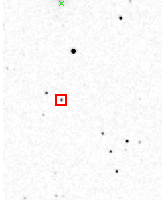2MASS
The Two Micron All-Sky Survey, or 2MASS, was an astronomical survey of the whole sky in infrared light.[1] It happened between 1997 and 2001, in two different places, Fred Lawrence Whipple Observatory in Arizona, and at the Cerro Tololo Inter-American Observatory in Chile, each using a 1.3-meter telescope for the Northern and Southern Hemisphere, in order.[2] It was organized in the short-wavelength infrared at three different frequency bands (J, H, and K) near 2 micrometres, from which the photometric survey with its Mercury cadmium telluride (HgCdTe) detectors takes its name.[1]
2MASS made an astronomical catalog with over 300 million observed objects, including minor planets of the Solar System, brown dwarfs, low-mass stars, nebulae, star clusters and galaxies. Also, 1 million objects were cataloged in the 2MASS Extended Source Catalog (2MASX). The cataloged objects are named with a "2MASS" and "2MASX"-prefix, in order.
References
- ↑ 1.0 1.1 "About 2MASS (A Brief Explanation of 2MASS)". University of Massachusetts, Infrared Processing and Analysis Center (JPL/ Caltech), NASA, NSF. 2006-02-01. Retrieved 2008-09-21.
- ↑ "Two Micron All Sky Survey (2MASS)". NASA/IPAC Infrared Science Archive. Retrieved 2011-10-22.
